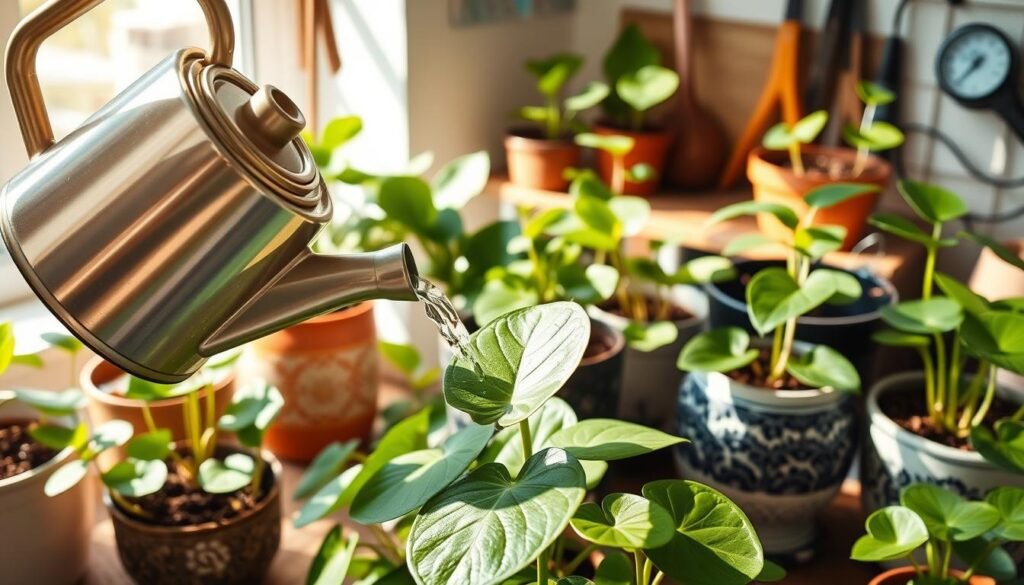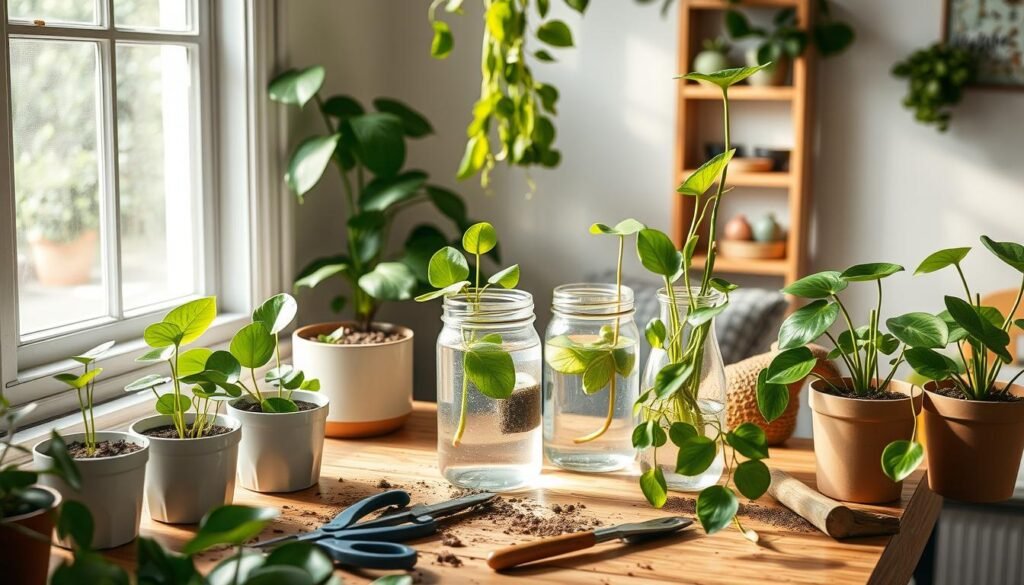Welcome to the world of the peperomia plant! It’s part of the Piperaceae family, with over 1,500 species. Each one is known for its beautiful leaves. They come from places like Mexico, South America, and the Caribbean.
These plants are loved by many because they’re easy to care for. They don’t need a lot of attention. Plus, they can handle not being watered often, which is great for people who are always busy.
Peperomia plants also clean the air, making your home healthier. They don’t take up much space, so they’re perfect for small areas. In this guide, you’ll learn how to keep your peperomia plants looking their best. You’ll find all the care tips you need.
Table of Contents
Introduction to Peperomia Plants
Peperomia plants are a favorite in indoor gardening because of their beautiful leaves. They come from warm places like Central and South America. These plants are small and have thick leaves, making them great for homes.
Peperomias are easy to care for and come in many shapes, sizes, and colors. About 40 species are popular for homes. They can grow well in different light levels, from bright to dim.
These plants need soil that drains well and should be watered carefully. This prevents root rot. They are safe for kids and pets, which makes them even more popular.
Adding a peperomia plant to your home can make it more lively. They are easy to care for and add beauty to any space. They are a favorite among gardeners and beginners alike.
Understanding Peperomia Varieties
Exploring peperomia varieties opens up a world of choices for indoor gardeners. With over 1,000 species, each type has unique features. This variety offers many popular peperomias, each with its own charm.
Popular Types of Peperomia
There are many popular types of peperomia to choose from. Each variety meets different tastes and styles. Here are a few examples:
- Watermelon Peperomia (Peperomia argyreia): This variety grows 6-12 inches tall. It has green stripes like a watermelon skin.
- Peperomia caperata ‘Luna Red’: It has textured leaves and won the Royal Horticultural Society’s Award of Garden Merit.
- Peperomia Rosso: It has longer, pointy leaves than many other types.
- Peperomia Mendoza: This hybrid has silvery green leaves with burgundy undersides, showing off unique colors.
- Raindrop Peperomia (Peperomia polybotrya): It has pointed, raindrop-like leaves. It can grow 12 to 15 inches tall.
These examples show how peperomias can beautify your indoor space. For more growing tips, check out a detailed guide here.
Distinctive Features of Peperomia Plants
The distinctive features of peperomia plants make them popular. Even within the same variety, there’s a wide range of leaf shapes, colors, and textures. For example:
| Variety | Leaf Shape | Color | Size |
|---|---|---|---|
| Peperomia caperata ‘Frost’ | Smaller, less rounded | Silvery-green | 6-12 inches |
| Peperomia abricos | Heart-shaped | Dark green with pink/red edging | 8-10 inches |
| Peperomia orba | Teardrop | Light green | 6 inches |
| Variegated Peperomia (Peperomia caperata ‘Variegata’) | Deeply ridged | Green with white/cream variegation | 8-12 inches |
This table shows some notable peperomia varieties and their unique features. Their varied leaf shapes and colors are perfect for an engaging indoor garden. Whether you pick the vibrant Watermelon Peperomia or the elegant Peperomia caperata ‘Luna Red’, each adds a special touch to your collection.
Peperomia Plant Care Essentials
Proper care for your Peperomia plants means knowing their light and soil needs. This knowledge helps you create the perfect home for them. It ensures they grow well and look beautiful.
Light Requirements for Peperomia
Peperomia plants do best in medium to bright indirect light. They can handle low indirect light, making them great for many rooms. But, they shouldn’t get direct sunlight, as it can burn their leaves.
A well-placed Peperomia will add beauty to your home. It also needs very little care.
Soil Preferences for Thriving Plants
Peperomia plants like loose, well-draining soil that keeps moisture but doesn’t get too wet. A mix made for orchids is perfect because it’s chunky and acidic. It’s important to prevent root rot by ensuring good drainage.
Check your soil often to make sure it’s not too packed. This lets your Peperomia grow well.
Watering Guidelines for Peperomia Plants
Watering is key to keeping your Peperomia plants healthy. Their leaves can store water, so they don’t need to be watered often. By following the right watering tips, you can keep your Peperomia plants strong and vibrant.

Water your Peperomia when the top two inches of soil feel dry. This usually means watering every 7 to 10 days. But, too much water can harm your plant, causing root rot. So, it’s important to check the soil moisture often.
In warmer months or when it’s less humid, you might need to water more. But in cooler times, you can water less. Paying attention to these watering tips will help your Peperomia stay healthy and happy.
- Check the soil moisture by inserting a finger into the soil.
- Water when the top two inches of soil are dry.
- Avoid letting the plant sit in excess water.
- Adjust your watering based on seasonal changes.
Temperature and Humidity Preferences
Knowing the right temperature and humidity is key for peperomia care. These plants love warm, humid places, just like their tropical homes. The right climate helps them grow well and avoid problems like leaf color changes and wilting.
Ideal Temperature Range
Peperomia plants do best in temperatures between 65°F to 80°F (18°C to 27°C). Keeping this range helps them stay healthy and grow strong. If it gets too cold (below 50°F or 10°C) or too hot (above 85°F or 29°C), they might get stressed.
It’s important to watch the temperature closely. Keeping it steady within 5-10°F helps your plant thrive.
Maintaining Humidity for Peperomia
Peperomia plants like it when the air is a bit moist to very moist. Bathrooms are great places for them. If your home is dry, you can use a trick like putting pots on trays with water and pebbles.
Also, misting your plants often helps keep the air right. Remember, you might need to change how you care for your plant with the seasons.
| Temperature Range | Effect on Peperomia |
|---|---|
| 65°F – 80°F (18°C – 27°C) | Optimal growth and flowering |
| 50°F – 64°F (10°C – 18°C) | Stalled growth |
| Below 50°F (10°C) | Increased risk of stress symptoms |
| Above 85°F (29°C) | Can cause wilting and growth issues |
Fertilizing Your Peperomia Plant
Fertilizing peperomia needs careful thought because they grow slowly. These plants need nutrients like nitrogen, phosphorus, and potassium. These are key for strong roots, stems, and leaves. You should choose a fertilizer that meets peperomia’s needs for healthy growth.
As peperomia grows, it uses up the nutrients in the soil. Indoor plants don’t get fresh soil like outdoor ones. Use a liquid fertilizer with a balanced NPK ratio, like 3-1-2, for better control.
Good choices for organic fertilizers are Espoma Organic Indoor! (2-2-2) and FoxFarm Grow Big – Liquid Concentrate (6-4-4). Mix two teaspoons of Espoma per quart of water or 2-3 teaspoons of FoxFarm per gallon. Feed your peperomia once or twice a month from spring to summer.
Watch for signs of nutrient problems. Yellow leaves might mean too little nitrogen. Dark blue-green or reddish purple leaves could show phosphorus issues. Wilting leaves and slow growth are signs of potassium deficiency.
Don’t fertilize your peperomia in winter to avoid damage. The right fertilizing keeps the soil rich. This supports a strong root system and good nutrient uptake.

| Nutrient | Function | Symptoms of Deficiency |
|---|---|---|
| Nitrogen | Promotes healthy leaf growth | Pale yellowing of older leaves |
| Phosphorus | Supports root development and flowering | Dark blue-green or reddish purple leaves |
| Potassium | Aids in overall plant health and stress resistance | Wilting leaves and stunted growth |
Repotting Peperomia: When and How
Repotting peperomia plants is key to their care. Knowing when to repot helps keep your plants healthy. These plants grow slowly and don’t need to be repotted often. But, it’s important to do so to avoid root-bound issues and promote growth.
Signs That Your Peperomia Needs Repotting
Look out for these signs that your peperomia needs a new home:
- Roots are visible through the drainage holes.
- The plant appears root-bound, with roots tightly coiling within the pot.
- The soil mix looks old or has degraded significantly.
- The plant’s growth has slowed down considerably, suggesting nutrient depletion.
- You notice that your plants are drying out quickly in between watering.
If you see these signs, it’s time to repot your peperomia. Choose a slightly larger pot for better growth and drainage. Use a mix of local potting soil, coco fiber, and other materials like succulent & cactus mix or orchid bark. This mix helps with water retention and drainage, which are vital for healthy roots.
Repotting every couple of years or as needed keeps your plants thriving. For more tips on soil mixes and repotting, check out this guide. The right soil mix and potting techniques are essential for your peperomia’s health.
| Soil Mix Component | Function |
|---|---|
| Local Potting Soil | Provides nutrients and structure. |
| Coco Fiber | Improves drainage and retains moisture. |
| Orchid Bark | Aids in aeration and prevents waterlogging. |
| Charcoal | Absorbs impurities in the soil. |
| Worm Compost | Enhances nutrient content. |
Propagating Peperomia Plants
Peperomia plants add joy to your indoor garden with their easy growth. Learning how to propagate them can make your garden even more vibrant. You can use stem cuttings, leaf cuttings, or divide larger plants. Each method has its own advantages and can help your plants thrive.
Different Methods of Propagation
Stem cuttings are a simple way to start new plants. Just take a stem with at least one leaf and put it in water or soil. Propagating peperomia in water lets you watch the roots grow, which takes a few weeks to a month. This is best done in early spring or summer.
Soil propagation also works well and can lead to stronger roots. This is because the roots get nutrients right away.
Best Practices for Successful Propagation
To grow peperomia successfully, keep the environment right for them. They need warmth and indirect light. Wrapping the pot in plastic helps keep moisture in.
Make sure the soil is moist but not too wet. Too much water can cause root rot. By following these tips, you can enjoy more peperomia plants in your home.

Common Pests and Diseases Affecting Peperomia
Knowing the threats to your Peperomia plants is key to keeping them healthy. Peperomias are tough, but pests and diseases can harm them. Watch your plants closely to catch problems early.
Identifying Common Pests
Mealybugs, spider mites, and whiteflies are common pests of Peperomia. They suck the plant’s juices, damaging leaves and stems. Look for discolored leaves, webbing, and a sticky feel on leaves to spot them.
Treatment Options for Peperomia Issues
To fight pests, use insecticidal soap or neem oil weekly. Keeping your plant clean and free of debris helps prevent pests too.
Peperomias can also get diseases like fungal spots, root rot, and ring spot virus. These often come from bad watering or infected cuttings. For example, ring spot virus shows as brown rings on leaves, while root rot means too much water. Make sure your Peperomia has good soil and humidity to fight diseases. For more help, check out this resource.
| Pest/Disease | Signs/Symptoms | Treatment Options |
|---|---|---|
| Mealybugs | Discolored foliage, sticky residue | Insecticidal soap; neem oil |
| Spider Mites | Fine webbing; yellow spots | Neem oil spray; increased humidity |
| Whiteflies | White flies under the leaves; yellowing | Insecticidal soap; remove sticky residue |
| Fungal Leaf Spot | Brown spots on leaves | Improve air circulation; avoid overhead watering |
| Root Rot | Wilting; dark, mushy roots | Reduce watering; improve drainage |
| Ring Spot Virus | Brown ring markings; stunted growth | Discard infected plants; use healthy cuttings |
By being proactive and using the right treatments, you can keep your Peperomia plants healthy and strong.
Pruning and Maintenance for Peperomia Plant
Keeping a Peperomia plant healthy means knowing how to prune peperomia properly. Pruning makes the plant fuller and removes dead or weak stems. It’s best to do this in early spring when the plant is growing most.
Using sharp scissors is key to avoid harming the plant. This also helps prevent diseases from spreading.
But pruning is just part of plant maintenance. Cleaning the leaves regularly is also important. Dust can block sunlight, which is bad for the plant. Clean leaves help the plant grow better and look nicer.
Here are some important tips for taking care of your Peperomia:
- Prune in spring to encourage bushier growth.
- Clean leaves monthly to ensure optimal light absorption.
- Check for pests regularly, addressing any infestations immediately.
- Repot every two years to refresh the soil and stimulate growth.
By following these steps for pruning peperomia and regular care, your plants will stay healthy and bright. For more tips, check out practical guides for different plants.

| Maintenance Task | Frequency | Notes |
|---|---|---|
| Pruning | Spring | Encourages bushier growth |
| Leaf Cleaning | Monthly | Prevents dust buildup |
| Fertilizing | Three times a year | Spring, summer, fall |
| Repotting | Every 2 years | Refresh soil and pot size |
| Pest Inspection | Regularly | Treat infestations promptly |
Benefits of Growing Peperomia Plants Indoors
Peperomia plants are not just pretty; they also offer many benefits for indoor spaces. One key advantage is their ability to purify the air. They remove harmful pollutants like formaldehyde, making your home healthier.
Air Purifying Qualities
Peperomia plants are great for homes and offices because they purify the air. They release water through their leaves, cooling the air and improving its quality. This makes them perfect for those who love plants and want a practical benefit.
Low Maintenance and Care Requirements
Peperomia plants are easy to care for, which is a big plus. They can survive with little water, needing it only every seven to ten days. This makes them perfect for people with busy lives or those new to gardening. For more tips on caring for your peperomia, check out this resource on peperomia care. Their hardiness and simplicity make them a great choice for indoor gardens.
Conclusion
Growing peperomia plants is more than a trend; it’s a journey that makes your indoor gardening better. These plants come in many unique varieties, adding lush greenery to your home. By following the care guide in this article, you can make your peperomia thrive.
Proper light, soil, and watering are key to a beautiful display of foliage. Avoiding common mistakes like overwatering is important. With consistent care, your plants will not only look great but also clean the air in your home.
Whether you’re new to plants or have experience, peperomia is a great choice. Propagating through stem cuttings or enjoying varieties like Watermelon Peperomia can make your indoor spaces lively. Enjoy the journey of growing peperomia and watch your garden become a peaceful oasis.



